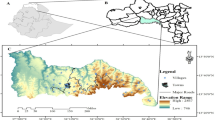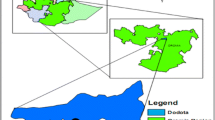Abstract
Rangeland degradation is a serious problem throughout sub-Saharan Africa and its restoration is a challenge for the management of arid and semi-arid areas. In Lake Baringo Basin of Kenya, communities and individual farmers are restoring indigenous vegetation inside enclosures in an effort to combat severe land degradation and address their livelihood problems. This study evaluated the impact of enclosure management on soil properties and microbial biomass, being key indicators of soil ecosystem health. Six reseeded communal enclosures using soil embankments as water-harvesting structures and strictly regulated access were selected, varying in age from 13 to 23 years. In six private enclosures, ranging from 3 to 17 years in age, individual farmers emulated the communal enclosure strategy and restored areas for their exclusive use. Significant decreases in bulk density, and increases in the soil organic carbon, total nitrogen and microbial biomass contents and stocks were found in the enclosures as compared with the degraded open rangeland. In the private enclosures, the impact of rehabilitation on the soil quality was variable, and soil quality was in general lower than that obtained under communal management. The significant increase of absolute stocks of carbon, nitrogen and microbial biomass compared to the degraded open rangeland indicates the potential for the restoration of soil quality through range rehabilitation. Over-sowing with indigenous legume fodder species could improve total nitrogen content in the soil and nutritional value of the pastures as well.
Similar content being viewed by others
References
Anderson J M, Ingram J S I. 1993. Tropical Soil Biology and Fertility: A Handbook of Methods. Wallingford, Oxon, England: CAB International, 221.
Ashrafa M, McNeillyb T. 1994. Responses of three arid zone grasses to N deficiency: A greenhouse study. Arid Soil Research and Rehabilitation, 8: 125–136.
Bradstreet R B. 1965. The Kjeldahl Method for Organic Nitrogen. London: Academic Press.
Brookes P C, Landman A, Pruden G, et al. 1985. Chloroform fumigation and release of soil nitrogen; a rapid extraction method to measure microbial biomass nitrogen in soil. Soil Biology and Biochemistry, 17: 837–842.
Chen D D, Zhang S H, Dong S K, et al. 2010. Effect of land-use on soil nutrients and microbial biomass of an alpine region on the north-eastern Tibetan plateau, China. Land Degradation and Development, 21: 446–452.
De Baets S, Poesen J, Gyssels G, et al. 2006. Effects of grass roots on the erodibility of topsoils during concentrated flow erosion. Geomorphology, 76: 54–67.
de Groot P, Field-Juma A, Hall D O. 1992. Reclaiming the Land: Re-vegetation in Semi-arid Kenya. Nairobi: ACTS Press, 105.
Descheemaecker K, Nyssen J, Rossi J, et al. 2006. Sediment deposition and pedogenesis in exclosures in the Tigray highlands, Ethiopia. Geoderma, 132: 291–314.
Ekaya W N, Kinyamario J I, Karue C N. 2001. Abiotic and herbaceous vegetation characteristics of an arid rangeland in Kenya. African Journal of Range and Forage Science, 18: 1–8.
FAO. 2001. Soil Carbon Sequestration for Improved Land Management. Rome: World Soil Resources Report No. 96.
FAO. 2006a. FAO World Reference Base for Soil Resources. Rome: Food and Agriculture Organization of the United Nations, 128.
FAO. 2006b. FAO Guidelines for Soil Description (4th ed.). Rome: Food and Agriculture Organization of the United Nations, 97.
Holt J A. 1997. Grazing pressure and soil carbon, microbial biomass and enzyme activities in semi-arid north-eastern Australia. Applied Soil Ecology, 5: 143–149.
Jenkinson D S. 1988. Determination of microbial biomass carbon and nitrogen in soil. In: Wilson J R. Advances in Nitrogen Cycling in Agricultural Ecosystems. Wallingford: CAB International, 368–386.
King E G, Hobbs R J. 2006. Identifying linkages among conceptual models of ecosystem degradation and restoration: towards an integrative framework. Restoration Ecology, 14: 369–378.
Kinyua D, McGeoch L E, Georgiadis N, et al. 2009. Short-term and long-term effects of soil ripping, seeding, and fertilization on the restoration of a tropical rangeland. Restoration Ecology, 18: 226–233.
Kipkorir E C. 2002. Analysis of rainfall climate on Njemps Flats, Baringo District, Kenya. Journal of Arid Environments, 50: 445–458.
Lal R. 2000a. Physical management of soils of the Tropics: priorities for the 21st Century. Soil Science, 165: 191–207.
Lal R. 2000b. World cropland soils as a source or sink for atmospheric carbon. Advances in Agronomy, 71: 145–191.
Little P D. 1996. Pastoralism, biodiversity and the shaping of savannah landscapes in East Africa. Journal of the International African Institute, 66: 37–51.
Mekuria W, Aynekulu E. 2011. Exclosure land management for restoration of the soils in degraded communal grazing lands in northern Ethiopia. Land Degradation and Development, 24: 528–538.
Mekuria W, Veldkamp E, Corre M D, et al. 2011. Restoration of ecosystem carbon stocks following exclosure establishment in communal grazing lands in Tigray, Ethiopia. Soil Science Society of America Journal, 75(1): 246–256.
Mekuria W. 2013. Conversion of communal grazing lands into exclosures restored soil properties in the semi-arid lowlands of Northern Ethiopia. Arid Land Research and Management, 27: 153–166.
Meyerhoff E. 1991. Taking Stock: Changing Livelihoods in a Agropastoral Community. Nairobi: African Centre for Technology Studies (ACTS) Press.
Milton S J, Dean W R J, du Plessis M A, et al. 1994. A conceptual model of arid rangeland degradation: the escalating cost of declining productivity. BioScience, 44: 70–76.
Moussa A S, Van Rensburg L, Kellner K, et al. 2007. Soil microbial biomass in semi-arid communal sandy rangelands in the western Bophirima district, South Africa. Applied Ecology and Environmental Research, 5: 43–56.
Murage E W, Karanja N K, Smithson P C, et al. 2000. Diagnostic indicators of soil quality productive and non-productive smallholders’ fields of Kenya’s Central Highlands. Agriculture, Ecosystems and Environment, 79: 1–8.
Mureithi S M. 2006. The effect of enclosures on rehabilitation of degraded semi-arid land in Lake Baringo Basin, Kenya. MSc. Thesis. Belgium: Ghent University.
National Park Service, U.S. Department of the Interior. 2014. Rangeland soil quality: soil compaction factsheet. [2014-01-28]. http://www.nature.nps.gov/geology/soils/Docs/Factsheet/Rangeland/Soil_Compaction.pdf.
Nelson R E. 1982. Carbonate and gypsum. In: Page A L, Millner RH, Keeney D R. Methods of Soil Analysis. Part 2. Chemical and Microbiological Properties. Madison: American Society of Agronomy and Soil Science Society of America, 181–197.
Northup B K, Brown J R, Holt J A. 1999. Grazing impacts on the spatial distribution of soil microbial biomass around tussock grasses in a tropical grassland. Applied Soil Ecology, 13: 259–270.
Opiyo F E O, Ekaya W N, Nyariki D M, et al. 2011. Seedbed preparation influence on morphometric characteristics of perennial grasses of a semi-arid rangeland in Kenya. African Journal of Plant Science, 5: 460–468.
Perrow M R, Davy A J. 2002a. Handbook of Ecological Restoration. Volume 1. Principles of Restoration. Cambridge: Cambridge University Press.
Perrow M R, Davy A J. 2002b. Handbook of Ecological Restoration. Volume 2. Restoration in Practice. Cambridge: Cambridge University Press.
Raiesi F, Asadi E. 2006. Soil microbial activity and litter turnover in native grazed and ungrazed rangelands in a semi-arid ecosystem. Biology and Fertility of Soils, 43: 76–82.
Rhoades J D. 1982. Methods of Soil Analysis. Part 2. Chemical and Microbiological Properties (2nd ed.). Madison: American Society of Agronomy and Soil Science Society of America.
Robinson G W. 1922. A new method for the mechanical analysis of soils and other dispersions. Journal of Agricultural Science, 12: 306–321.
Ruiz-Jaen M C, Aide T M. 2005. Restoration success: how is it being measured? Restoration Ecology, 13: 569–577.
Society for Ecological Restoration (SER). 2004. The SER International Primer on Ecological Restoration. Tucson: Society for Ecological Restoration International [2012-03-10]. http://www.ser.org.
Thom D J, Martin N L, 1983. Ecology and production in Baringo-Kerio valley, Kenya. The Geographical Review, 73: 15–29.
Tongway D J, Ludwig J A. 2011. Restoring Disturbed Landscapes: Putting Principles into Practice (The Science and Practice of Ecological Restoration Series). Washington, DC: Island Press, 191.
USDA-SCS/GoK, 1978. Reconnaissance Soil Survey of Lake Baringo-Kerio Valley Area. Nairobi: Ministry of Agriculture Project Evaluation and Management Division, Government of Kenya.
Verdoodt A, Mureithi S M, Van Ranst E. 2010. Impacts of management and enclosure age on recovery of the herbaceous rangeland vegetation in semi-arid Kenya. Journal of Arid Environments, 74: 1066–1073.
Walkley A, Black I A. 1934. An examination of the Degtjareff method for determining organic carbon in soils: effect of variations in digestion conditions and of inorganic soil constituents. Soil Science, 63: 251–263.
Wasonga V O. 2009. Linkages between land-use, land degradation and poverty in semi-arid rangelands of Kenya: the case of Baringo district. PhD Dissertation. Nairobi: University of Nairobi.
Wasonga V O, Nyariki D M, Ngugi R K. 2011. Assessing socio-ecological change dynamics using local knowledge in the semi-arid lowlands of Baringo, Kenya. Environmental Research Journal, 5: 11–17.
Wu J, Joergensen R G, Pommerening B, et al. 1990. Measurement of soil microbial biomass C by fumigation-extraction-an automated procedure. Soil Biology and Biochemistry, 22: 1167–1169.
Author information
Authors and Affiliations
Corresponding author
Rights and permissions
About this article
Cite this article
Mureithi, S.M., Verdoodt, A., Gachene, C.K.K. et al. Impact of enclosure management on soil properties and microbial biomass in a restored semi-arid rangeland, Kenya. J. Arid Land 6, 561–570 (2014). https://doi.org/10.1007/s40333-014-0065-x
Received:
Revised:
Accepted:
Published:
Issue Date:
DOI: https://doi.org/10.1007/s40333-014-0065-x




